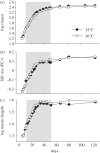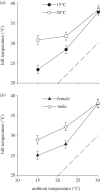Post-hatch heat warms adult beaks: irreversible physiological plasticity in Japanese quail
- PMID: 23884093
- PMCID: PMC3735260
- DOI: 10.1098/rspb.2013.1436
Post-hatch heat warms adult beaks: irreversible physiological plasticity in Japanese quail
Abstract
Across taxa, the early rearing environment contributes to adult morphological and physiological variation. For example, in birds, environmental temperature plays a key role in shaping bill size and clinal trends across latitudinal/thermal gradients. Such patterns support the role of the bill as a thermal window and in thermal balance. It remains unknown whether bill size and thermal function are reversibly plastic. We raised Japanese quail in warm (30°C) or cold (15°C) environments and then at a common intermediate temperature. We predicted that birds raised in cold temperatures would develop smaller bills than warm-reared individuals, and that regulation of blood flow to the bill in response to changing temperatures would parallel the bill's role in thermal balance. Cold-reared birds developed shorter bills, although bill size exhibited 'catch-up' growth once adults were placed at a common temperature. Despite having lived in a common thermal environment as adults, individuals that were initially reared in the warmth had higher bill surface temperatures than cold-reared individuals, particularly under cold conditions. This suggests that blood vessel density and/or the control over blood flow in the bill retained a memory of early thermal ontogeny. We conclude that post-hatch temperature reversibly affects adult bill morphology but irreversibly influences the thermal physiological role of bills and may play an underappreciated role in avian energetics.
Keywords: Allen's rule; ontogeny; phenotypic plasticity; thermal window.
Figures


Similar articles
-
The evolution of the avian bill as a thermoregulatory organ.Biol Rev Camb Philos Soc. 2017 Aug;92(3):1630-1656. doi: 10.1111/brv.12299. Epub 2016 Oct 7. Biol Rev Camb Philos Soc. 2017. PMID: 27714923 Review.
-
Heat loss may explain bill size differences between birds occupying different habitats.PLoS One. 2012;7(7):e40933. doi: 10.1371/journal.pone.0040933. Epub 2012 Jul 25. PLoS One. 2012. PMID: 22848413 Free PMC article.
-
Geographical variation in bill size across bird species provides evidence for Allen's rule.Am Nat. 2010 Aug;176(2):188-97. doi: 10.1086/653666. Am Nat. 2010. PMID: 20545560
-
Huffin' and puffin: seabirds use large bills to dissipate heat from energetically demanding flight.J Exp Biol. 2019 Nov 8;222(Pt 21):jeb212563. doi: 10.1242/jeb.212563. J Exp Biol. 2019. PMID: 31624096
-
Effects of thermal stress during rest and exercise in the paediatric population.Sports Med. 1998 Apr;25(4):221-40. doi: 10.2165/00007256-199825040-00002. Sports Med. 1998. PMID: 9587181 Review.
Cited by
-
Tests of ecogeographical relationships in a non-native species: what rules avian morphology?Oecologia. 2016 Jul;181(3):783-93. doi: 10.1007/s00442-016-3590-9. Epub 2016 Mar 2. Oecologia. 2016. PMID: 26936361
-
Allometry reveals trade-offs between Bergmann's and Allen's rules, and different avian adaptive strategies for thermoregulation.Nat Commun. 2023 Feb 27;14(1):1101. doi: 10.1038/s41467-023-36676-w. Nat Commun. 2023. PMID: 36843121 Free PMC article.
-
Limited evidence that body size shrinking and shape-shifting alleviate thermoregulatory pressures in a warmer world.Commun Biol. 2025 May 7;8(1):707. doi: 10.1038/s42003-025-08131-7. Commun Biol. 2025. PMID: 40335683 Free PMC article.
-
Spatial variation in avian bill size is associated with temperature extremes in a major radiation of Australian passerines.Proc Biol Sci. 2024 Jan 31;291(2015):20232480. doi: 10.1098/rspb.2023.2480. Epub 2024 Jan 24. Proc Biol Sci. 2024. PMID: 38262606 Free PMC article.
-
A prenatal acoustic signal of heat affects thermoregulation capacities at adulthood in an arid-adapted bird.Sci Rep. 2022 Apr 7;12(1):5842. doi: 10.1038/s41598-022-09761-1. Sci Rep. 2022. PMID: 35393484 Free PMC article.
References
-
- Schneider RA. 2005. Developmental mechanisms facilitating the evolution of bills and quills. J. Anat. 207, 563–573 (doi:10.1111/j.1469-7580.2005.00471.x) - DOI - PMC - PubMed
-
- Schluter D, Price TD, Grant PR. 1985. Ecological character displacement in Darwin finches. Science 227, 1056–1059 (doi:10.1126/science.1128374) - DOI - PubMed
-
- Grant PR, Grant BR. 2006. Evolution of character displacement in Darwin's finches. Science 313, 224–226 (doi:10.1126/science.1128374) - DOI - PubMed
-
- Podos J. 2001. Correlated evolution of morphology and vocal signal structure in Darwin's finches. Nature 409, 185–188 (doi:10.1038/35051570) - DOI - PubMed
-
- Scott GR, Cadena V, Tattersall GJ, Milsom WK. 2008. Body temperature depression and peripheral heat loss accompany the metabolic and ventilatory responses to hypoxia in low and high altitude birds. J. Exp. Biol. 211, 1326–1335 (doi:10.1242/jeb.015958) - DOI - PubMed
Publication types
MeSH terms
LinkOut - more resources
Full Text Sources
Other Literature Sources

